
Cold temperatures will continue across much of the eastern U.S. into today. Heavy lake effect snow continues into today east of Lakes Erie and Ontario. Two Pacific cold fronts will cross the Pacific Northwest early this week followed by another atmospheric river. Heavy rain and gusty winds are expected through midweek, with the potential for renewed urban and river flooding. Read More >

Welcome to the National Weather Service Fort Worth / Dallas Office! |
||
|
|
|
|
|
Office Address
|
Contact Information Email: sr-fwd.webmaster@noaa.gov |
.png)
NWS Fort Worth geographic region
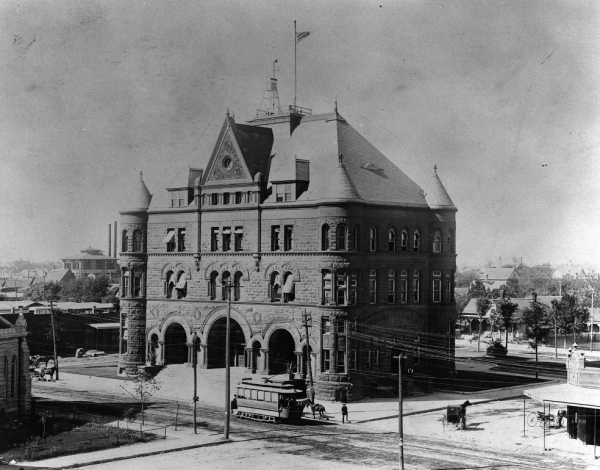
Federal Building in Downtown Fort Worth, ca. 1898
Jack White Photograph Collection, UTA Libraries
The Fort Worth Office Is Born
On September 1, 1898, a Weather Bureau office opened in the federal building in downtown Fort Worth. The building, which also housed the city’s post office, was located at Jennings Avenue and 11th Street. At the time, the Fort Worth station was one of nine Weather Bureau outposts in the state of Texas. Although the weather forecasts originally came from the district office in New Orleans, Fort Worth residents came to rely on the flags hoisted next to the rooftop weather equipment, describing the day’s weather and warning of any hazards.
The Weather Bureau in Dallas
A sister office was established in Dallas on October 15, 1913. Dr. Joseph L. “Joe” Cline, younger brother of Dr. Isaac Cline, was selected to head the new office. Beginning in 1892, the younger Cline had served as an assistant to his brother Isaac, who was in charge of the Galveston office. During that time, both Clines did their graduate studies through Add-Ran Christian University (now Texas Christian University in Fort Worth). After the 1900 hurricane destroyed the Galveston office, the brothers were relocated to other Weather Bureau offices. Joe eventually found his way to Corpus Christi before transferring to the new Dallas office, and Isaac settled in New Orleans where he would create the weather and river forecasts for both Dallas and Fort Worth.
The Great Depression
The Depression brought about budget cuts and multiple relocations. In 1934, the Fort Worth office moved to the new U.S. Court House on the opposite side of 10th Street. The original federal building, which was sold to the city of Fort Worth in 1937, was eventually torn down in 1960; Fort Worth City Hall now occupies the site. With further budget constraints late in the decade, the downtown offices in both Fort Worth and Dallas were consolidated with their respective airports (Meacham Field and Love Field). Both relocations were completed during 1940 when the Weather Bureau was moved from the Department of Agriculture to the Department of Commerce.
Additional Moves and Reorganization of the Agency
A regional office was established in Fort Worth on January 1, 1942. In 1949, the regional office in Atlanta was consolidated into the Fort Worth office, which became responsible for all of the South Central and Southeast U.S. In April 1953, forecasts and official observations moved to Amon Carter Field (the name of which was changed to Greater Southwest International Airport in 1962). In 1956, the Weather Bureau established a student trainee program to introduce meteorology majors to the agency; Fort Worth’s first participant arrived in 1959. The responsibility for public weather forecasts was passed from New Orleans to Fort Worth in 1960. In the summer of 1966, a new federal building was completed on Taylor Street in downtown Fort Worth, housing both the regional and weather forecast offices. On October 1, 1970, the Weather Bureau was renamed the National Weather Service under the newly formed National Oceanic and Atmospheric Administration (NOAA). As part of this process, the number of weather forecast offices across the country more than doubled to 50, generally one office per state. Fort Worth's Weather Forecast Office in downtown Fort Worth was one of three in Texas; San Antonio and Lubbock were the others. In August 1974, the official observations moved from the defunct Greater Southwest to the newly built Dallas/Fort Worth International Airport.
|
Office at Amon Carter Field |
Weather Forecast Office in the New Federal Building |
Our Current Location
In November 1993, the Weather Forecast Office moved from the federal building in downtown Fort Worth to the north side of the city. The open area would better accommodate the launching of weather balloons, and the following summer, the upper air unit at Stephenville was moved to the new Fort Worth office. The Stephenville office was closed in 1995. By the end of 1998, a similar satellite office at Waco also ceased operations. The Weather Forecast Office in Fort Worth assumed responsibility for 46 counties across North and Central Texas, which it continues to serve from its facility on Northern Cross Blvd.
|
Launching a Pilot Balloon at Meacham Field in 1943 |
Launching a Helium-Filled Weather Balloon in 1945 |
Upper Air Observations
Beginning in 1894, the Weather Bureau had employed kites to make upper air observations. On July 1, 1931, the kite observing sites at Groesbeck (Texas) and Broken Bow (Oklahoma) were replaced with airplane upper air observations (APOBs) from Dallas Love Field. Just three years later, the flights were transferred to Oklahoma City. Throughout the 1930s and 1940s, pilot balloons (pibals) were employed to assess winds above the surface. In the decades that followed, weather balloons launched from Fort Worth’s Carswell Air Force Base were the region’s primary source for upper air data. In 1973, the upper air operations were moved to Stephenville where they remained until being transferred to the new Fort Worth office in 1994.
|
Launching the First Weather Balloon at NWS Fort Worth in 1994 |
Launching a Weather Balloon Today (September 2019) |
Aviation Services
Following the enactment of the Air Commerce Act of 1926, the Dallas Airways and Observing Office was established at Dallas Love Field on July 16, 1930. The office, which provided weather-specific aviation services, was moved to Fort Worth Meacham Field on September 1, 1937. It was then relocated to Amon Carter Field in 1953. As part of the Modern Aviation Forecasting System, aviation weather services were expanded in 1960 with additional Weather Bureau personnel. In 1978, the Center Weather Service Unit (CWSU) was established near DFW Airport; the CWSU continues to serve the aviation weather needs at one of the busiest airports in the world.
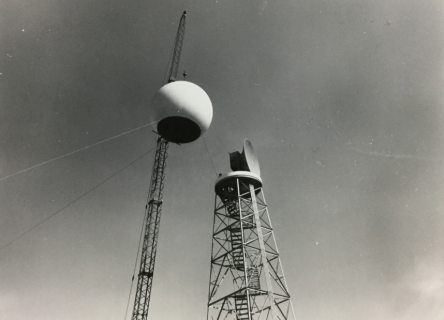
Installation of the WSR-57 Radar at Fort Worth in 1961
Weather Radar
On April 21, 1954, a WSR-1 radar was commissioned at Amon Carter Field (later known as Greater Southwest International Airport). By 1955, there were 19 such radars across Texas and Louisiana as part of the Texas Radar Project. Under the program, the Weather Bureau acquired surplus Navy radars, and with funding from local communities, the Texas Research Foundation at Texas A&M University modified the radars to be used for weather surveillance. On April 5, 1961, Fort Worth’s new-and-improved WSR-57 radar was commissioned. In 1973, this radar was moved to Stephenville. A Next Generation Radar (NEXRAD), the WSR-88D, was the first weather radar to incorporate Doppler technology. Construction began on Fort Worth’s WSR-88D in late 1993 at Spinks Airport, and the radar become operational in December 1994. The Fort Worth office was also responsible for WSR-88D radars allotted to Fort Hood and Abilene’s Dyess Air Force Base. The WSR-57 radar was then decommissioned, and the co-located office at Stephenville was shuttered.
NOAA Weather Radio
As a service to mariners, the Weather Bureau began radio broadcasts in 1965. Their popularity gave rise to additional stations inland. On February 11, 1972, weather radio transmitters were established in Dallas and Fort Worth. The local network expanded to Sherman/Denison and Paris in 1978. Due to the increase in workload, local universities provided the voices for the broadcasts until 1985 when the Weather Forecast Office in Fort Worth resumed these duties. The Fort Worth office acquired a fifth station in Waco when the NWS office there was set for closure. During the first decade of the 21st century, eight additional transmitters were added across North and Central Texas.
Preparedness and Office Outreach
A warning coordination position was introduced in 1968. It was formally named the Warning and Preparedness Meteorologist (WPM) in 1979. The first WPM in Fort Worth was Al Moller, who was instrumental in developing one of the nation’s first networks of weather spotters. His slide presentations, compiled from his own photography, were used nationwide to train spotters. In 1994, the WPM was converted into the Warning Coordination Meteorologist (WCM) position, responsible for preparedness and outreach. In addition to the WCM, a Science and Operations Officer (SOO) was also created that year, the SOO’s focus being research and training. The WCM and SOO serve as deputy managers under the Meteorologist in Charge (MIC), who heads the office.
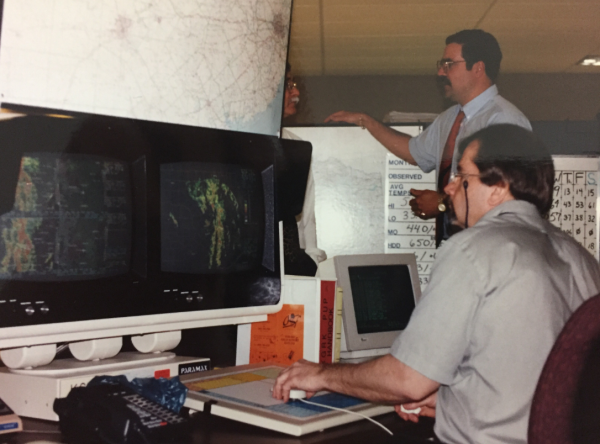
NEXRAD WSR-88D PUP (Principal User Processor)
Al Moller is seated at the PUP as MIC Skip Ely (left) and WCM Jim Stefkovich (right) discuss.
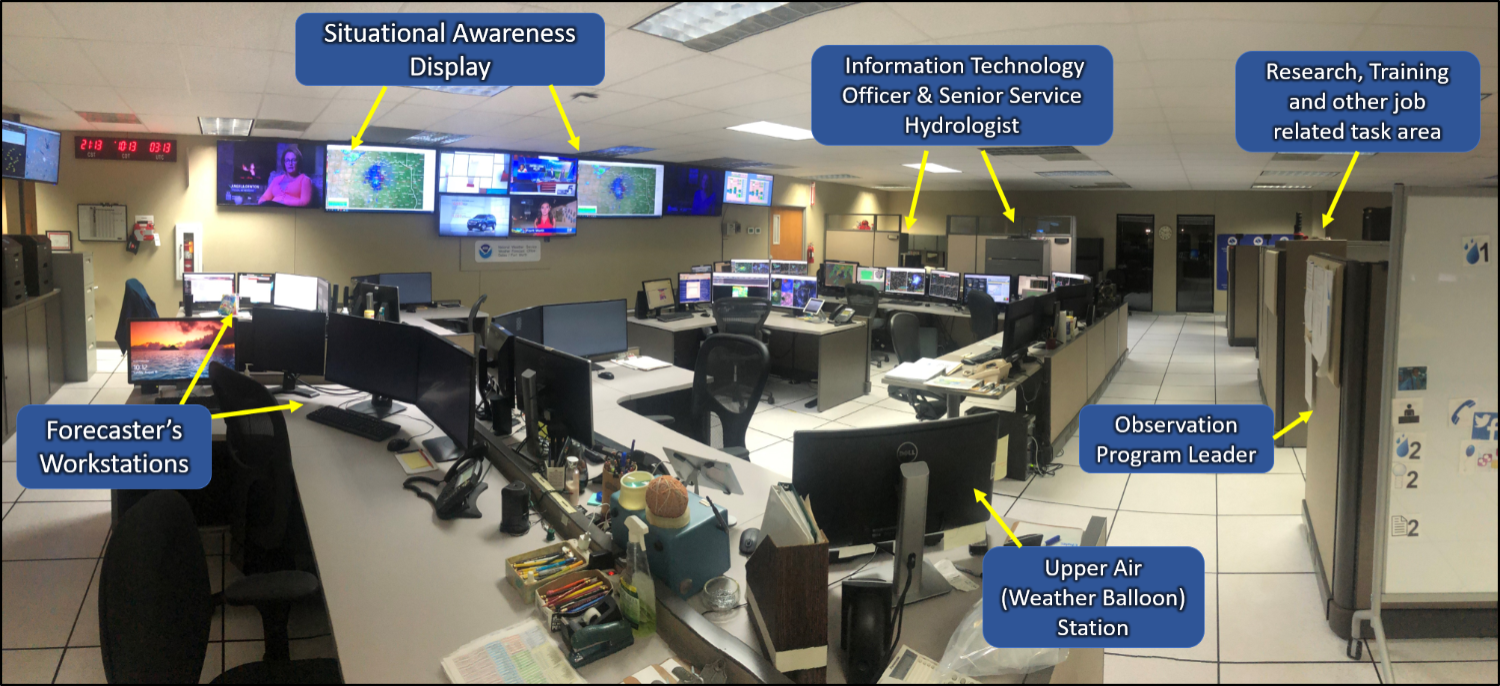
This is an overview picture of the operations area of the National Weather Service (NWS) Office in Fort Worth, TX. This is where the warning and forecast process takes place. We are staffed 24/7/365 with at least 2 people on duty at all times. The wall of television screens, or Situational Awareness Display is where we monitor local and national television stations, radar and satellite, and other displays to keep the forecasters up to date on the evolving weather conditions.
The cubicles (to the right and back) are used by the Information Technology Officer (ITO), Senior Service Hydrologist (SSH), the Observation Program Leader (OPL), and other staff members to conduct research and other job related tasks.
The upper air observations provide data essential for weather forecast and research. Weather balloons carry an instrument called a radiosonde which is tracked by specialized ground equipment. The NWS at Fort Worth / Dallas conducts these observations at least twice a day. They are launched at our office at 00 UTC and 12 UTC (6 AM and 6 PM CDT and 5 AM and 5 PM CST). Weather balloons are simultaneously launched at 92 NWS radiosonde stations in the contiguous U.S. (69 sites), Alaska Region (13), Caribbean (1), and Pacific Region (9). Special weather flights are occasionally launched ahead of a hazardous weather event or to conduct research.
See the video below to learn more about the radiosonde and how we prepare and launch the balloon.
Upper Air Observations & Maps
Storm Prediction Center (SPC): Soundings and Soundings Climatology Page
College of DuPage: Surface and Upper Air Analysis Products
Upper Air Observations Program
Fact Sheet - information on radiosondes
What do you do if you find a weather balloon / radiosonde
JetStream - about radiosondes
In order to provide the wide variety of services that the NWS provides, a number of important pieces of equipment are utilized. The table below is a list of equipment used in our office to aide in daily activities.
| Equipment | Uses |
| Advanced Weather Interactive Processing System (AWIPS) | Display system for hydro-meteorological operations. |
| Automated Surface observation System (ASOS) | Sensors measure wind, temperature, moisture, sky condition, visibility, present weather information, obstructions, pressure, and precipitation. |
| Cooperative Observation Equipment (COOP) | Measures temperature and precipitation. |
| Doppler Weather Radar | Detects, analyze and display precipitation. |
| Hydrologic Observing Systems | Gauges measure river stage/flow. |
| NOAA Weather Radio | Official warning and forecast voice of the NWS. |
| Radiosonde and Tracking System | Measure wind, temperature and moisture through different levels of the atmosphere. |
Most of this equipment is maintained by our technicians and support staff. The NWS Fort Worth has three Electronic Technicians, one IT Specialist, one Information Technology Officer and one Electronic System Analyst to support this services. The Observation Program Leader is responsible of maintaining the COOP sites.
Pictures: Coming Soon!
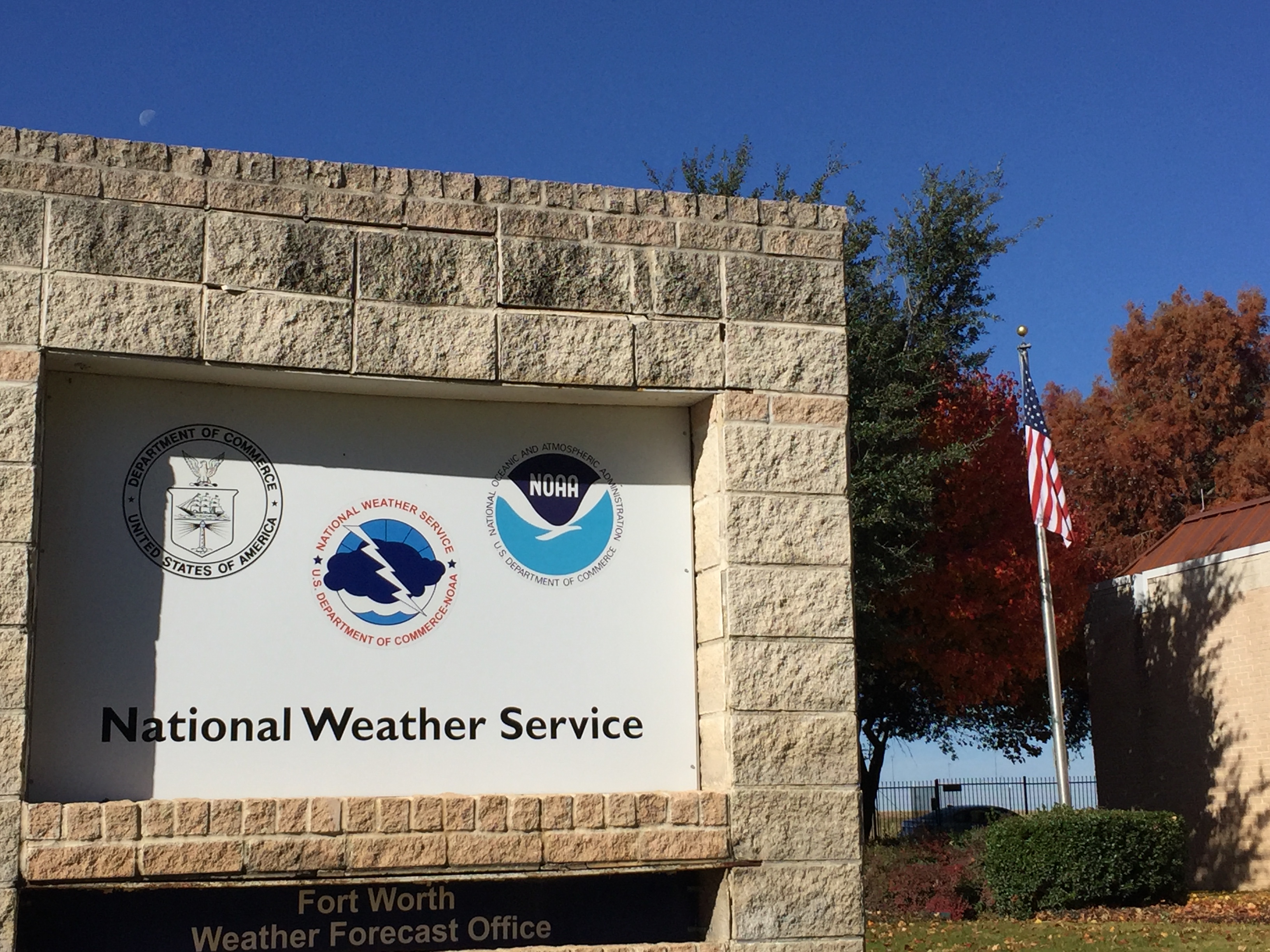 |
NWS Fort Worth Office Tour and The National Weather Service (NWS) Forecast Office in Fort Worth, Texas promotes outreach to our community by offering tours of our office and presentations for adults and school-age children. We also provide guest speakers who can present information on weather safety, the science of meteorology, and the mission of the NWS.
|
|
Tours Visit our main Tours webpage to learn more about it and how to schedule a tour. |
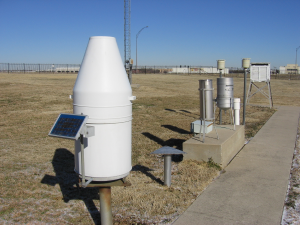 |
|
Guest Speakers
|
|
|
Student Opportunities
|
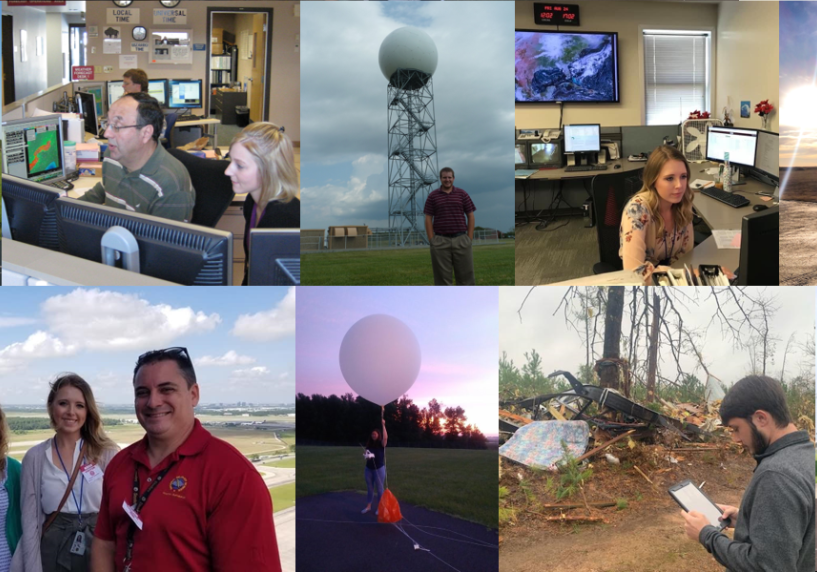 |
|
|